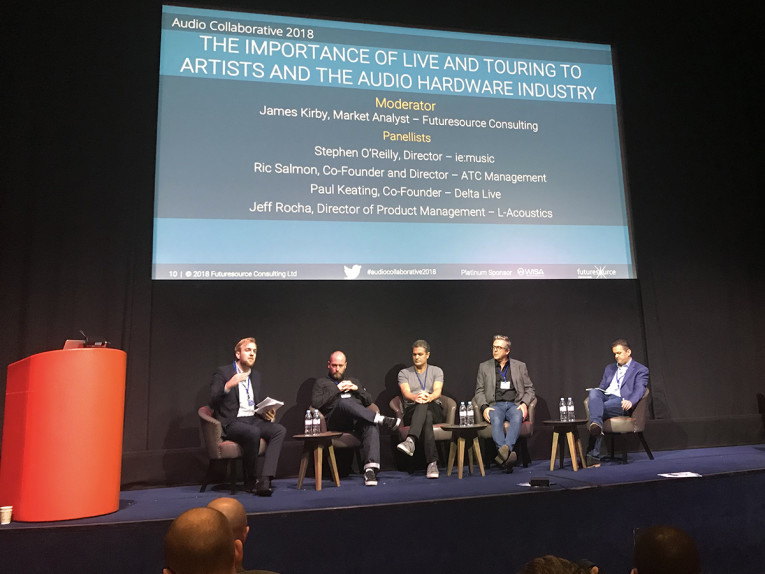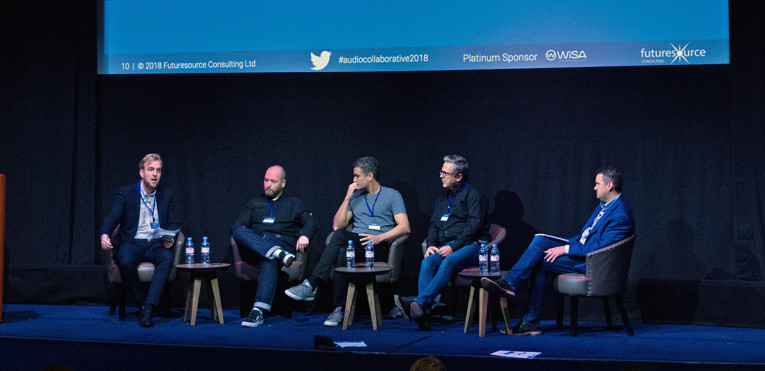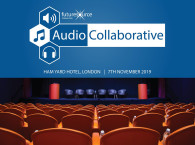Featuring inspiring presentations, discussion panels, and great summaries of Futuresource's market data and forecasts, in front of an audience predominantly consisting of industry professionals, the sessions deserve to be shared with a wider audience than those in the room. Futuresource makes audio recordings of all sessions available on YouTube here. But I know that's not something for which we all have time. So, I thought that I should look at another two of the sessions, the panels discussing live and touring trends, and how the pro audio industry can leverage opportunities in the consumer space; and try to summarize some key content, and maybe add some context and perspective.

"The Importance of Live and Touring to Artists and the Audio Hardware Industry," was one of the most topic-rich panels, with excellent perspective and questions from Futuresource market analyst James Kirby to Stephen O’Reilly, Director of ie:music (mainly speaking from the artist management perspective); Ric Salmon, Co-Founder and Director ATC Management (also with a great perspective in artist management and production); Paul Keating, Co-Founder Delta Live (bringing the essential rental, events, and audio design perspective); and Jeff Rocha, Director of Product Management for L-Acoustics (contributing with the perspective of a professional loudspeaker manufacturer, and a leading one in concert touring and systems for large venues.)
As Kirby pointed out to kick things off, Futuresource research indicates that the loudspeaker market on the pro audio side remains quite strong but seldom do we discuss its trends from the perspective of how artists, managers, and suppliers see the potential to capture further growth. In general, the panel agreed with the growth opportunities and that artists continue to be able to see their activities expand from live shows.
As Salmon, from ATC management pointed out, given the evolution of the recording industry to streaming services, "From a revenue perspective, a successful artist gets 70% to 80% of its revenues from live performances, on average. And streaming is now the big driver for artists to manage their schedule and expand their global coverage." Interestingly as he noted, as streaming grows "and the physical media cash cow for the industry fades away" the industry embraced and adapted to new metrics, and it actually allows musicians to sell more tickets and merchandise... and also physical media, CDs, and vinyl records.
As Salmon also reminded the audience, since it became a market connected to digital streaming services, the industry evolved toward a global model. "Streaming has accelerated the consumption of music, in a more broadly democratized way, and lowered the entry barriers, and while more fans now have access to the music, they also buy tickets to live shows. The evolution of streaming not only provides an opportunity to communicate with music in a different way, and access it in a far more broad and fluent way, but above all it enables artist managers to know where the fans are. While with the physical media it was an entirely anonymous purchase, now the industry is an entirely personalized experience. Artist management, right holders, and record companies know precisely who the buyers are, where they live, what consumption habits they might have, what that user listened before to listening to a certain album, and what shows he attended."

All this information about trends and consumption enables the industry to react faster and provides an enormous opportunity for the live sector as it evolves further. As O’Reilly also mentioned, bands are promoting concerts in countries where they previously didn't even knew they had fans, and artists even will create a set list according to their music preferences, based on country-specific Spotify data.
This also helps to produce more profitable shows because data provides an overview on the number of fans in a certain city, and it enables promoters to sell tickets in advance using the social aspects of streaming platforms, while producers can reliably predict if the tour should consider two shows in a certain venue, given the capacity and interest generated.
Even though this is early days and record labels and managers are still adapting to the amount of data available, those who are adopting it quickly are able to grasp massive opportunities - all members of the panel agreed that live performances are going to evolve and grow in the next few years.
The reflex of this transition in terms of audio hardware, is that the industry is no longer just focusing on making sure the artist is seen and heard, but actually providing unique experiences to the fans. Also, the profitability of the shows makes it possible to invest in better systems... and more speakers.

According to Rocha, L-Acoustic is now promoting the immersive L-ISA concept, which no longer restricts sound design to left/right or left/center/right PA arrays, and instead surrounds the space with multiple arrays. This concept creates the ability to make sure that everyone inside the venue is able to listen perfectly to the source, and not the PA, and allow the public to "share the space" with the artist. Also, according to Rocha, technology is making it possible to use larger venues, with much better quality.
This panel of industry experts agreed that touring and festivals are growing significantly and that revenues from live shows and events are increasing. Also, the public buying tickets for live shows and festivals is now a new generation with a different expectation – much more demanding. "That's what is driving the next generation of innovation in technology with multichannel deployment, object-based mixing, and the immersive experience that results from changing the whole experience of audio," stated Rocha.
Still, audio remains a relatively modest part of the show or touring budget, when compared with stage, lighting, video, and scenic technology. While the production values for global tours are huge, audio is increasing as well, but is still a fraction of the overall budget.
More importantly, as Delta's Keating pointed out, the introduction of immersive, multichannel systems is extremely well received and his company has seen something unusual, which is the audience praising the sound after the show. "While previously people would only comment on the sound when it was really bad." Keating also shared that recent classical performances at Royal Albert Hall in London, made it virtually impossible to distinguish the presence of the sound reinforcement system, creating a much more balanced experience. According to Keating, the L-ISA experience – which he describes as "hyperreal sound," makes large venues sound more intimate, as though the artist was singing "just for us."
For rental companies, these innovations are helping their clients to see the value and get the extra budget. Producers of live shows have tried many different ways to create different experiences for concert-goers, but most of the solutions have not proved scalable and they quickly lose the novelty factor. "Immersive audio is not a ‘novelty’ and can help the live industry sustain growth," Keating confirmed.
Pro and Consumer Audio Converge
Not exactly in sequence, the Audio Collaborative 2018 conference included that same day another panel comparing market trends in the pro audio and consumer audio spaces. The panel featured Robert Morgan-Males, CEO of Audio-Technica; Sam Inglis, Features Editor from Sound on Soundmagazine; Sarah Yule, Director of Sales at ROLI; and Ivor Taylor, founder of Grand Central Recording Studios (GCRS).

From that panel, I particularly appreciated the statements from Yule, reflecting the position of ROLI, a musical instruments company that was born just five years ago with the attitude and marketing prowess of a major consumer electronics and lifestyle brand. Yule recognized there is a huge growth in the industry around audio technology in general without ever giving any specifics about the MI segment but saying a lot about how the company positions itself in the current trends – and I have no doubt that ROLI's market growth will enable it to rival other major brands in a short period of time.
She enthusiastically explained how audio brands can differentiate from the rest, creating a story behind the brand, achieving relevance to its audience, and maintaining authenticity – all things that so many musical instrument companies have completely forgotten. I also think it is the main reason for their demise, even though some of those same brands themselves are worth far more than the actual business turnover of the companies these days.

She obviously mentioned the need to highlight emotions and the "soul of products," apart from its functionalities, and acknowledge that a brand's success can be built independently of the price range, even when a product can be considered a luxury item. Apart from having a great story and staying relevant, ROLI invests in making the user recognize its core values and offer the best possible experience, which might mean generating great music - or great audio, for the examples of other companies she discussed.
Interestingly, Audio-Technica discussed precisely how the company has been using the revived interest around vinyl - a market which is at the core foundation of the brand - to reach out to a new generation of consumers and build upon the emotional experience of touching and playing a record. Morgan-Males stated that they are confident that vinyl revival is "not a fad" and that there is a younger user who values the experience. He also mentioned how the massive adoption of smartphones, which are bundled with headphones also because they are music players, are now creating another major incentive for consumers to buy audio equipment.
According to Morgan-Males there's a new generation that is now evolving from the concept of convenience to demand higher audio quality, and that's what is driving market growth in Audio-Technica's consumer product segments, which includes headphones. While in pro audio, Audio-Technica continues to focus on specs as a sales argument. But that's precisely where the brand has seen an interesting overlap, where their "pro" studio headphones are bought and highly praised by consumers, even leading the company to recently launch a "consumer" wireless version of its flagship ATH-M50 headphone - the ATH-M50xBT.

He admitted that pro audio has a lot to learn about that crossover with consumer audio and getting the balance right between quality and convenience. As an example, Audio-Technica is pushing the concept of hi-res audio (HRA) from the professional side, and pushing it to the consumer, explaining that marrying an HRA player with an HRA headphone will provide a better user experience. The problem in that particular case, is streaming services are not yet offering mainstream options for consumers.
Another important reference mentioned by the panel was the fact that the omni channel distribution is becoming increasingly important, with digital platforms such as Amazon, while direct to consumer is something that no brand can ignore, even if they need the support of a traditional distribution channel, as in pro audio. But with online channels growing globally, the concept of the exclusive distributor is now gone.
Again, ROLI is an example of a company that deals particularly well with this extremely complex equation, especially when recognizing that its customers are musicians and artists, which can be massively influential. As Yule specifically mentioned, the marketing campaign for a product launch is now entirely in the hands of the brand, but the regional challenge remains. She mentioned, the root to market as being a combination of reach, physical presence of the brand, distribution (storage), and localization to make it relevant to any market. And that's valid for both digital or physical channels.
Read more summaries of Audio Collaborative 2018:
Audio Collaborative 2018 Key Takes
Voice Pervades the Smart Home
Music Market Outlook - Changes and Opportunities
I hope this will trigger your appetite to attend the Audio Collaborative event next year. Combining the latest market research intelligence, this is a unique opportunity to share the latest insightful industry trends, among key industry influencers, and discuss how services, hardware, and content is shaping the future of the audio landscape.







